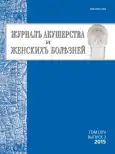Клинико-анамнестические факторы риска смешанного недержания мочи у женщин
- Авторы: Русина Е.И.1
-
Учреждения:
- ФГБНУ «НИИ АГиР им. Д. О. Отта»
- Выпуск: Том 64, № 3 (2015)
- Страницы: 33-39
- Раздел: Статьи
- URL: https://journals.rcsi.science/jowd/article/view/1249
- DOI: https://doi.org/10.17816/JOWD64333-39
- ID: 1249
Цитировать
Полный текст
Аннотация
Ключевые слова
Полный текст
Открыть статью на сайте журналаОб авторах
Елена Ивановна Русина
ФГБНУ «НИИ АГиР им. Д. О. Отта»
Email: pismo_rusina@mail.ru
к. м. н., старший научный сотрудник отделения оперативной гинекологии
Список литературы
- Аль-Шукри С. Х., Кузьмин И. В. Симптоматика, клиническое течение и лечение гиперактивности мочевого пузыря у женщин. Гинекология. 2008; 10 (4): 78-80.
- Аполихина И. А. Клиническая эпидемиология, дифференциальная диагностика и консервативное лечение недержания мочи у женщин. Автореф. дис… д-ра мед. наук. М.; 2006.
- Петрова В. Д. Недержание мочи у женщин (этиопатогенез, клиника, диагностика, лечение). Автореф. дис… д-ра мед. наук. М.; 2005.
- Русина Е. И. Роль комплексного уродинамического исследования при планировании оперативного лечения у континентных женщин с пролапсом тазовых органов. Журнал акушерства и женских болезней. 2014; LXIII (1): 17-25.
- Русина Е. И., Беженарь В. Ф., Иващенко Т. Э., Пакин В. С., Баранов В. С. Особенности полиморфизма генов MMP1, ММP3, PAI1 у больных с пролапсом тазовых органов и стрессовым недержанием мочи. Акушерство и гинекология. 2014; 9: 63-8.
- Шварц П. Г. Нейрогенные нарушения мочеиспускания у больных с острыми и хроническими сосудистыми заболеваниями головного мозга (клиника, диагностика и лечение). Автореф. дис… д-ра мед. наук. М.; 2013.
- Botlero R, Davis SR, Urquhart DM, Bell RJ. Incidence and resolution rates of different types of urinary incontinence in women: findings from a cohort study. J. Urol. 2011; 185 (4): 1331-7.
- Brown J. S., Jackson R. A., Kanaya A. M. Urinary incontinence in elderly women: The health, aging and body composition study. 2-nd International Consultation on Incontinence: abstract. Paris; 2001: 24.
- Campeau L, Gorbachinsky I, Badlani G.H, Andersson K. E. Pelvic floor disorders: linking genetic risk factors to biochemical changes. BJU Int. 2011; 108 (8): 1240-7.
- Cody JD, Jacobs ML, Richardson K, Moehrer B, Hextall A. Oestrogen therapy for urinary incontinence in post-menopausal women. Cochrane Database Syst. Rev. 2012;17 (10): CD001405.
- Elbadawi A., Yalla S. V., Resnick N. M. Structural basis of geriatric voiding dysfunction. I. Methods of a prospective ultrastructural/urodynamic study, and an overview of the findings. J. Urol. 1993; 150 (5 Pt2): 1650-6.
- Frick A. C., Huang A. J., Van den Eeden S. K., Knight S. K., Creasman J. M., Yang J., Ragins A. I., Thom D. H., Brown J. S. Mixed urinary incontinence: greater impact on quality of life. J. Urol. 2009; 182 (2): 596-600.
- Hannestad Y. S., Rortveit G., Sandvik H., Hunskaar S. A community-based epidemiological survey of female urinary incontinence: the Norwegian EPINCONT study. J. Clin. Epidemiol. 2000; 53 (11): 1150-7.
- Khullar V., Sexton C. C., Thompson C. L., Milsom I., Bitoun C. E., Coyne K. S. The relationship between BMI and urinary incontinence subgroups: results from EpiLUTS. Neurourol. Urodyn. 2014; 33 (4): 392-9.
- Kim H., Yoshida H., Suzuki T. Risk factors associated with urinary incontinence in community-dwelling elderly women. Nippon Ronen Igakkai zasshi. 2008; 45 (3): 315-22.
- Ohlsson B. L., Fall M., Frankenberg-Sommar S. Effects of external and direct pudendal nerve maximal electrical stimulation in the treatment of the uninhibited overactive bladder. Br. J. Urol. 1989; 64 (4): 374-80.
- Parazzini F., Chiaffarino F., Lavezzari M., Giambanco V. Risk factors for stress, urge or mixed urinary incontinence in Italy.Br. J. Obst. Gynaecol. 2003; 110 (10): 927-33.
- Strasser H., Tiefenthaler M., Steinlechner M., Eder I., Bartsch G., Konwalinka G. Age dependent apoptosis and loss of rhabdosphincter cells. J. Urol. 2000; 164 (5): 1781-5.
- Subak L. L., Wing R., West D. S., Franklin F., Vittinghoff E. Creasman J. M., Richter H. E., Myers D., Burgio K. L., Gorin A. A. Macer J., Kusek J. W., Grady D. Weight loss to treat urinary incontinence in overweight and obese women. Engl. J. Med. 2009; 360 (5): 481-90.
- Zhang W., Song Y., He X., Huang H., Xu B., Song J. Prevalence and risk factors of overactive bladder syndrome in Fuzhou Chinese women. Neurourol. Urodyn. 2006; 25 (7): 717.
Дополнительные файлы







